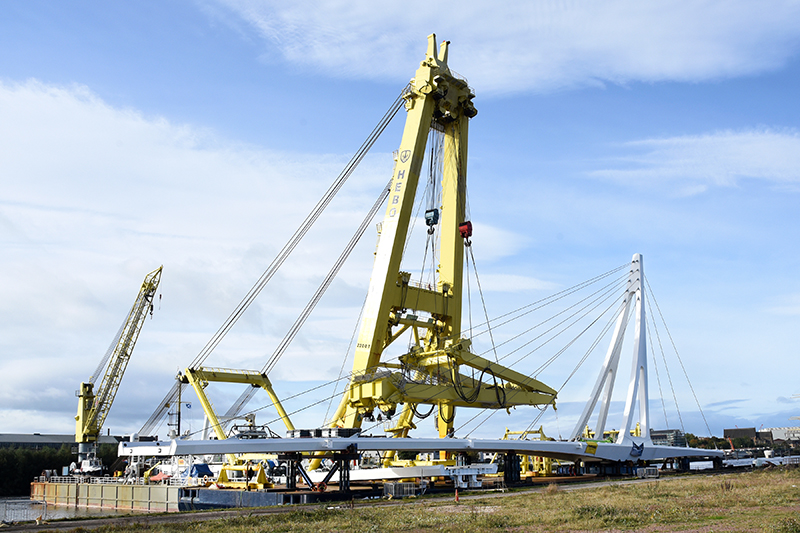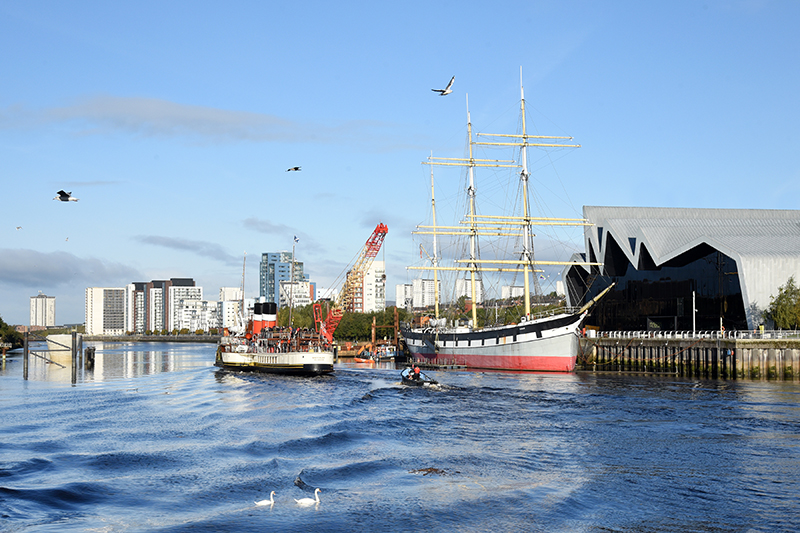
FARRANS’ decision to have the main span of the landmark Govan – Partick Bridge built entirely offsite is continuing to pay off, following the recent series of storms that have battered Europe, Project Scotland has been told.
The main span of the bridge recently arrived at Yorkhill Quay, close to the site where it was installed, after sailing up the River Clyde by barge.
The £29.5 million Glasgow City Region City Deal project includes the construction of a new pedestrian/cycle bridge over the River Clyde between Govan and Partick, re-establishing the historic connection between the areas.
David Buchanan, project manager for Farrans Construction, told Project Scotland that it had initially been planned for the bridge to be built in parts and transported to site in segments. However, it was entirely constructed and painted in factory conditions in Belgium, meaning that tricky and potentially dangerous works were undertaken in controlled conditions.
“Our thinking was that doing as much in a controlled environment would get the best quality bridge without any issues caused by external conditions such as weather, dust, and the usual quality issues and concerns you have when building a bridge outside,” David explained. “The bridge came across fully-assembled, the cables have been fully stressed, and building it offsite has reduced the need for working over water, which puts people at risk.


“Everything was done on the ground, it was controlled, and done on cherry pickers; they weren’t working off boats, dealing with tides, high winds – it was all done safely and those that were handling the bridge were able to go home at night rather than spend six months in Glasgow and back and forth on planes, which also benefits the project’s carbon footprint.”
After being completed in the factory, the bridge span had to navigate Belgium’s canals and bridges to make its way to Holland so that the final 30-metre pylon could be fitted.
Planning for its journey from Holland to Glasgow’s quayside began in December 2022, with factors such as wind and wave heights considered.
Particular concern was directed towards parts of the Channel, which resulted in extra sea fastening being engaged on the bridge.
However, after an almost fault-free journey, it was forced to dock in Greenock overnight – causing a one-day delay in the project.


“Only doing the one trip instead of multiple trips across the Channel was definitely a good decision,” David added, before pointing to how the delayed days could have added up if it had come in multiple parts.
“We were then able to lift the bridge into position and the barge got back to Rotterdam safely before the storms hit.”
Works prior to the bridge span arriving went by without any major hiccups, despite some being anticipated during piling on the south side of the bridge at the old Govan ferry outlet. David explained there was a chance of coming across historic structures from the old Govan ferry quayside, such as old walls and mooring points. However, some of the 95 piles were changed to ground bearing to ensure the structures were avoided.
From now until Christmas, the focus will be on electric and hydraulic fit-outs – with the span connected to the mechanical anchorage on the south pier.
This will be followed by testing and commissioning, before the crossing surface and handrails are fitted and final stressing undertaken.


The bridge span is six metres wide and was fabricated in two parts: the moving span, which weighs 650 tonnes, is 99 metres long and will use the South Pier (at Water Row) as its access; and the fixed span, which weighs 45 tonnes,is 15.7 metres long and spans between the North Pier and the Quayside at the Riverside Museum.
The project is due to complete in summer 2024.
Most of the project team hails from the central belt of Scotland or made it their home. David, who has worked all over the UK for a number of companies, said he has never really come across this before – and it’s brought about benefits.
Originally from Ireland, David and his wife made Glasgow their home in the 2000s. Now with children who are growing up in the city, he explained how he and others on the project are viewing the work as a way to repay a city that has given them so much.
“I think being able to say you’ve been able to give back to Glasgow is quite nice,” he added. “There’s a lot of pride in the bridge; it’s not just steel and concrete – it’s something the project team will be able to talk about with their family for years to come. I’m looking forward to bringing my own kids to it.”
The project team scored full marks in its Considerate Constructors audit, with David explaining that the ‘Excellent’ mark comes down to a number of reasons. One is Glasgow City Council and the Glasgow City Region City Deal team, who he said have helped build a great relationship that has ensured the project is a ‘harmonious’ place to work.
Another is the work of community benefit coordinator Marie Buchanan, who has undertaken a series of initiatives with the local communities including weekly breakfast events and regular visits from universities in Edinburgh and Glasgow, which has resulted in students returning on placement. Regular visits to schools and nurseries have also been undertaken, alongside Marie offering mentoring to youngsters at night.
A particular benefit of the bridge is that it will improve accessibility to major attractions including the Riverside Museum and resources to learn about Glasgow’s shipbuilding heritage.
“It’s going to be very accessible and I think that’s something that Marie has noticed that schools are really excited about it,” David added. “There’s a general buzz in Govan as well, as people there are looking forward to that connection back across to the Partick side. Bell’s Bridge is in Govan, but it’s further down and not in a residential area; this is in the middle, right in the heart of Govan and it’ll give that community a connection that’s been missing.”













